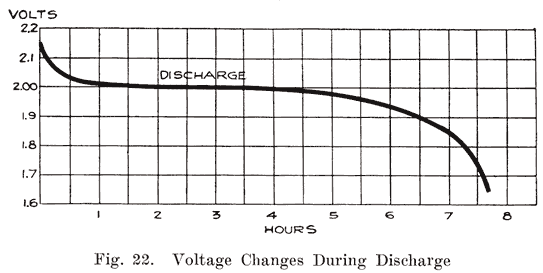Thanks to Peter Lindemann and John Bedini especially, I now know how the 12V lead acid battery manufacturers have been ripping us off for over 90 years. Consider the following figures from OA Witte’s “The Automobile Storage Battery – Its Care And Repair” dated 1922, which is available here, here or here.
You may be familiar with how a battery’s voltage changes as it discharges, as follows:

Voltage drops from a peak of about 2.2V per cell (so 13.2V for the standard 6 cell 12V battery) to a relatively constant 2V (hence the name of the 12V battery) for a few hours, before it drops off. What most people don’t know is what is actually happening in the battery. One of the plates is Lead Oxide (Pb.O) and the other (sponge) Lead (Pb). The electrolyte is Sulphuric Acid (H2SO4) in Water (H2O). The Hydrogen ions in the electrolyte combines with the oxygen from the Lead Oxide plates to create H2O, i.e. Water, and on BOTH plates the sulphate ions combine with the lead to produce Lead Sulphate (PbSO4), which is why the voltage/current eventually drops to nothing – both plates become identical in chemistry. Also, the battery is basically a water fuel cell.
Now, the really interesting figure follows:

This shows you that over 90 years ago it was known in the industry that to PROPERLY charge a battery (i.e. disassociate all the sulphate ions from the plates back into the water to form Sulphuric Acid) you need to charge a cell to about 2.7 V, i.e. 16.2 V for a 12 V battery. What do you get if you buy a battery charger, however? According to the self-proclaimed Battery University the correct voltage for recharging such a battery is only 2.3-2.45 V per cell, i.e. a maximum of 14.7 V. So what does this do to the battery? It ensures that not all of the Lead Sulphate is recovered, so each time the battery is discharged a thin layer of electrolyte is deposited on the plates, reducing the overall voltage and capacity of the battery, until it dies – i.e. planned obsolescence.
So, millions of dollars are wasted every year whilst tonnes of toxic lead are dumped in landfills merely because the industry doesn’t want to provide us with proper chargers. Actually, there are a few extra tricks you need to be aware of – e.g. the sulphate ions are fairly large, and as such require a bit of a push to get moving, but then thanks to momentum continue to move after the initial force. What this means is that rather than providing a constant voltage during charging you should charge in pulses – about 20% on, 80% off.
Anyway, the only battery chargers I know of that DO actually charge a battery properly are made by a company set up by Peter Lindemann & John Bedini, called Tesla Chargers. I own the cheap 2A12 model, and as an experiment I purchased 2 identical 12V batteries & charged one with the Tesla charger, the other with a normal charger. I treated the batteries very harshly, feeding into a 240V transformer to power a 60W light to discharge them, yet on the Tesla charger the capacity actually INCREASED over time – until it was 30% higher than the rated figure (in amp-hours; Ah). The normal charger, as expected, led to the battery rapidly reducing in capacity until it was virtually useless after a few weeks. Putting it on the 2A12 rejuvenated it somewhat, although not as good as the one I had on it all the time (although that might have been because I just didn’t do it long enough). If I had the dough I’d buy the Battery Rejuvenator to properly restore batteries automatically – it both charges and discharges batteries continually until they’re running optimally.
The Tesla Charger works on Nickel Cadmium (Ni-Cd) and Nickel Metal Hydride (NiMH) batteries as well as Lead Acid; although they don’t work on Lithium Ion batteries or other types one suspects that these batteries are also recharged with planned obsolescence in mind, which would explain why the first generation of iPhone batteries only lasted a year (Apple wanted people to throw away their old phone & buy a new one at this point, but underestimated customer backlash & meant for the battery to last closer to 2 or 3 years).
BTW, on a similar note I purchased Bedini’s Crystal Light Kit, which uses a new “battery” technology (really semiconductor) that although low voltage/amperage (enough to brightly light an LED) supposedly last forever without running out – it only needs to be topped up with water. This is just another example of the sort of energy technologies that industry are routinely suppressed by vested interests.